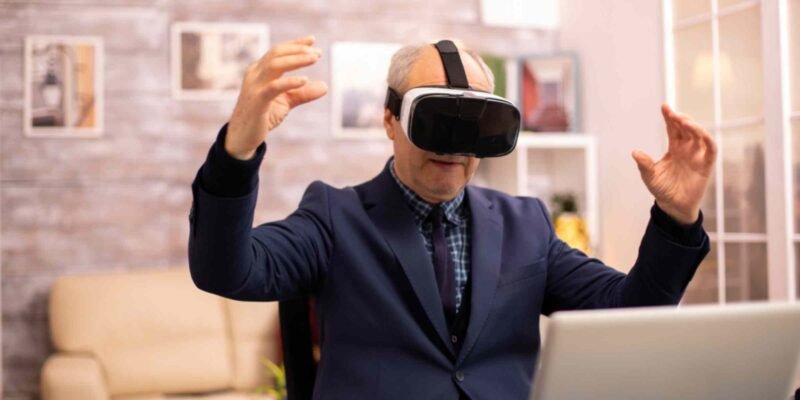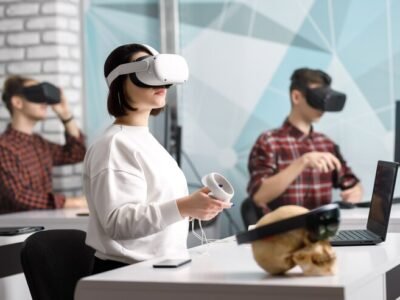
Imagine being able to transport your customers to a virtual showroom, let them experience your products in stunning 3D, and create unforgettable brand experiences – all without leaving the comfort of their homes. Sound like science fiction? Think again. Virtual reality is reshaping how we do business.
From immersive training to data visualization and enhanced customer engagement, virtual reality technology is rapidly transforming industries and giving companies a competitive edge. By embracing this cutting-edge innovation, businesses can unlock new realms of productivity, creativity, and growth.
Overview of VR’s Business Applications
You’ve probably heard of VR being used for gaming and entertainment purposes. But did you know that virtual reality is also making massive waves across various industries? From manufacturing giants to healthcare pioneers, companies are tapping into VR’s limitless potential to gain a competitive edge.
Whether enhancing employee training, creating immersive marketing campaigns, or visualizing complex data – VR has become an indispensable tool for forward-thinking businesses. And this is just the beginning. As the technology continues evolving, we’ll see even more groundbreaking applications emerge.
- In retail, VR enables customers to virtually “try on” clothes or visualize furniture in their homes before making a purchase.
- Real estate agents use VR to give prospective buyers captivating virtual tours of properties.
- Architects can walk clients through photo-realistic 3D renderings of proposed building designs.
These are just a few examples. The possibilities are truly endless when it comes to leveraging virtual reality to streamline operations, boost efficiency, and deliver extraordinary customer experiences. But before we explore VR’s current and future business applications, let’s take a quick look at how this mind-blowing technology evolved.
A Brief History of VR’s Corporate Evolution
While the concept of virtual reality has been around since the 1960s, it was initially considered more of a gimmick than a practical tool. Early VR systems were clunky, expensive, and lacked the computing power to create truly immersive experiences.
It wasn’t until the late 2000s and early 2010s that major technological breakthroughs – like improved display technologies, motion tracking, and more powerful graphics processing – made VR a viable solution for real-world applications.
Companies began exploring how this emerging tech could enhance operations. Initial use cases included training simulations for high-risk industries like aviation and the military. But as VR hardware and software rapidly advanced, its corporate uses expanded exponentially.
Today, businesses across diverse sectors are investing heavily in virtual reality to capitalize on its transformative potential. Let’s explore some key areas where VR is making massive impacts.
Training and Skill Development
One of VR’s most powerful applications is in employee training and skill development programs. By creating hyper-realistic 3D simulations, companies can provide hands-on training experiences without the risks and costs associated with real-world environments.
Healthcare: Medical students can practice complex surgical procedures in a risk-free virtual operating room before ever picking up a scalpel.
Manufacturing: Factory workers can be trained to operate heavy machinery and identify potential hazards through immersive VR simulations.
Soft Skills: Customer service reps can undergo virtual reality role-playing scenarios to improve communication and conflict resolution abilities.
| Low Risk | High Risk | |
|---|---|---|
| Real-World | Minimal training benefits | Too dangerous |
| VR Simulation | Effective and safe training | Effective and safe training |
As this table illustrates, VR offers a sweet spot for delivering effective, risk-free training – whether the real-world scenario is low or high risk.
Beyond its safety benefits, VR training can lead to significant cost savings by reducing equipment, travel, and facility needs. It also allows training to be standardized and repeated as needed for consistent skill mastery.
Many leading companies like Walmart, Boeing, and UPS have already implemented large-scale VR training initiatives. As the technology matures, expect immersive learning to become the norm across all major industries.
Marketing and Customer Engagement
In today’s crowded marketplace, brands are locked in an ongoing battle to capture consumer attention and build lasting connections. This is where virtual reality shines, allowing companies to create unforgettable, multi-sensory experiences that deeply engage customers.
Imagine exploring a photorealistic 3D rendering of a new car model, being able to sit inside, change the interior finishes with a click, and even take it for a virtual test drive – all from the comfort of your living room. This level of immersive, personalized interaction simply can’t be replicated through traditional 2D advertising.
Innovative brands have already capitalized on VR to build excitement around product launches and forge emotional bonds with consumers:
- Lowe’s offered customers a “Holoroom How-To” virtual reality experience to learn home improvement skills in an immersive home environment.
- The British Army created a gripping VR experience simulating a behind-the-scenes reconnaissance mission to generate interest among potential recruits.
- Merrell used VR to transport people to breathtaking camping destinations as part of their #TRAILSFOR360 marketing campaign.
As you can see, VR provides a powerful medium for telling captivating brand stories, driving product engagement, and cultivating customer loyalty in ways conventional marketing can’t match.
Collaboration and Remote Work
With more companies embracing distributed workforces, finding ways to bridge the physical gaps between teams is crucial for maintaining productivity and cohesion. Virtual reality offers a game-changing solution for enabling seamless remote collaboration.
Using VR headsets or mobile devices, remote employees can connect in a shared 3D virtual environment that simulates the experience of being in the same physical space. This allows for more natural real-time interactions, almost as if teams were working side-by-side.
VR meeting rooms facilitate collaborative tasks like editing documents, reviewing designs or prototypes, and brainstorming sessions. This immersive dynamic beats video conferencing by fostering more engaging and productive collaborative experiences.
Companies are also leveraging VR for remote assistance and training scenarios. An offsite expert could virtually guide a field technician through repairing complex equipment or a surgeon could receive real-time virtual coaching on a procedure from a more experienced colleague – broadening access to knowledge sharing across any distance.
In industries like construction and manufacturing that rely on global supply chains, VR offers new capabilities for coordinated planning and execution of large-scale projects with stakeholders around the world.
As remote work continues gaining momentum, expect virtual collaboration platforms to proliferate and become a cornerstone of the modern distributed workplace.
Data Visualization and Analysis
In the era of big data, companies must sift through and extrapolate meaning from vast, complex data sets to uncover strategic insights that drive growth and innovation. However, making sense of information presented across static 2D charts, graphs, and spreadsheets can be challenging and lead to missed opportunities.
Virtual reality data visualization flips this on its head by allowing users to immerse themselves within interactive 3D visual representations of their information. This radically improves our ability to spot patterns, trends, and correlations obscured in traditional formats.
Picture being able to walk through a virtual 3D scatter-plot of interconnected consumer data points, zooming in to different perspectives and uncovering previously hidden customer segments. Or exploring the virtual interior of an engine prototype, disassembling components layer-by-layer to analyze design performance metrics that would be difficult to conceptualize on a flat screen.
VR data visualization offers clear benefits for numerous industries
- Finance: Analyze vast datasets to spot market trends, calculate risk exposures and make smarter investment decisions.
- Healthcare: Visualize the human body to detect disease markers and plan targeted treatment.
- Manufacturing: Gain deeper insights into product performance and streamline production processes.
- Aerospace: Design and test vehicle prototypes in immersive virtual environments.
With VR, raw numerical data is transformed into compelling visual experiences that enhance cognition. This empowers data-driven organizations to capitalize on the full value of their information assets like never before.
Customer Experience Enhancement
While VR is revolutionizing the way companies design products, market services, and train staff – it’s also allowing brands to completely reimagine their customer-facing operations. By creating extraordinarily immersive and personalized experiences, businesses can forge deeper emotional connections with consumers and foster unprecedented levels of engagement and loyalty.
In retail, major brands are leveraging virtual reality to transform the shopping experience from top to bottom. Customers can seamlessly transition between browsing a brand’s metaverse storefront to virtually trying on clothes and accessories using a VR headset or their mobile device’s camera – without ever stepping foot in a physical store.
VR is also enhancing post-purchase engagement through virtual user groups, consultations with product experts, and interactive tutorials teaching consumers how to use or maintain the goods they’ve purchased. That lawnmower, appliance, or piece of electronics now comes with an immersive virtual manual that makes guidance much more intuitive and sticky.
Even industries like automotive are capitalizing on VR experiences for customers. Car shoppers can explore photorealistic 3D vehicle configurators, customize their dream ride down to the smallest details, and even take it for a simulated test drive before purchase – no dealership visit required.
The travel and tourism sector is another prime example of how VR is elevating customer engagement to new heights. Instead of browsing flat 2D photos or videos, travelers can literally teleport themselves to vividly recreated resorts, natural landscapes, and destinations across the globe – allowing them to experience the sights, sounds, and ambiance before committing to their next adventure.
This privileged level of pre-experience, once reserved for the realms of science fiction, is quickly becoming an expectation. And companies who want to thrive must meet consumers’ ever-rising demands for rich, personalized digital engagements by embracing the capabilities of VR.
Future Trends and Overcoming Challenges
While virtual reality’s impacts on business are undeniably profound, this powerful technology is still in its relative infancy – and both its full potential and limitations remain to be seen.
Undoubtedly, as VR hardware and development tools continue advancing, we’ll see increasingly photorealistic and seamless virtual experiences that push the boundaries of what’s possible. But there are very real challenges companies must surmount:
Costs: While VR prices are dropping, implementing robust enterprise-grade solutions with desired scalability remains a major investment.
User Experience: Creating fluid, intuitive virtual interfaces and interactions still requires significant UX design expertise.
VR Accessibility: Not everyone can currently experience VR due to cost accessibility, technical proficiency levels, and factors like vision/mobility constraints or conditions like VR motion sickness.
Privacy & Security: Introducing immersive technology into mission-critical business operations raises data privacy and cybersecurity concerns that must be addressed.
However, innovators refuse to let such hurdles obstruct their vision of mainstream virtual reality integration. Tech giants like Meta (Facebook) are leading a charge to make VR increasingly consumer-friendly and cost-effective with products like the Meta Quest headset. Meanwhile, enterprise software companies like VMWare are pioneering business-grade collaboration tools.
As these barriers fall, analysts predict the global VR market could surge over $120 billion by 2028, with applications spanning healthcare, education, engineering, real estate, retail, and virtually every major industry. Businesses must start developing their “VR strategies” now to capitalize on virtual reality’s immense potential for future disruption and transformation.
Conclusion
What was once science fiction is now reality. Virtual reality has escaped the realm of imagination and video games to become a transformative force reshaping how organizations operate, collaborate, and serve their customers.
From the training room to the design studio, sales floor to the operating theater, and everywhere in between – VR is proving to be an indispensable tool for the modern workforce. Its ability to immerse users in vividly simulated environments is upending conventional training, marketing, collaboration, and customer engagement methods.
More than just a novelty, companies are harnessing VR to unlock new frontiers of productivity, safety, data-driven insights, and brand experiences elevated to new heights. Those investing early are positioning themselves ahead of the curve in an ever-digitalizing business landscape where immersive technologies will be key competitive differentiators.













